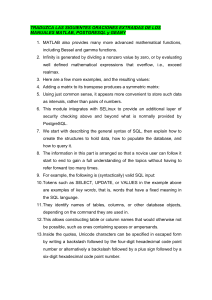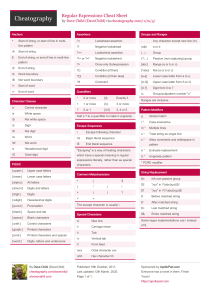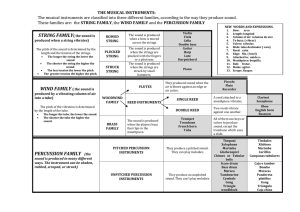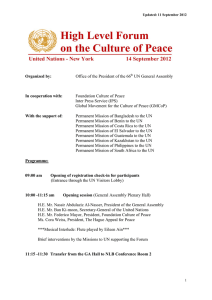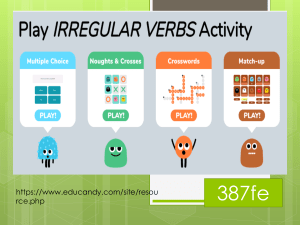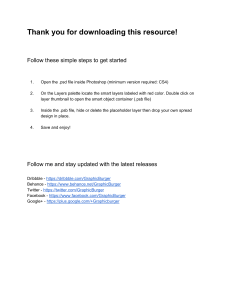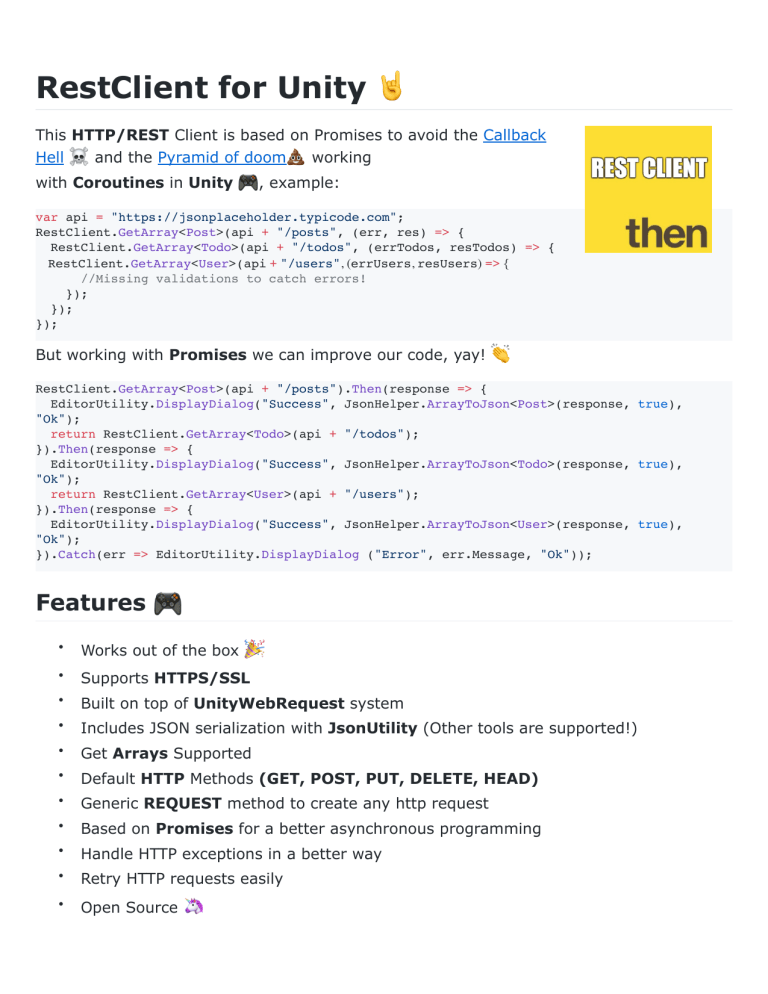
RestClient for Unity 🤘
This HTTP/REST Client is based on Promises to avoid the Callback
Hell ☠ and the Pyramid of doom💩 working
with Coroutines in Unity 🎮 , example:
var api = "https://jsonplaceholder.typicode.com";
RestClient.GetArray<Post>(api + "/posts", (err, res) => {
RestClient.GetArray<Todo>(api + "/todos", (errTodos, resTodos) => {
RestClient.GetArray<User>(api + "/users", (errUsers, resUsers) => {
//Missing validations to catch errors!
});
});
});
But working with Promises we can improve our code, yay! 👏
RestClient.GetArray<Post>(api + "/posts").Then(response => {
EditorUtility.DisplayDialog("Success", JsonHelper.ArrayToJson<Post>(response, true),
"Ok");
return RestClient.GetArray<Todo>(api + "/todos");
}).Then(response => {
EditorUtility.DisplayDialog("Success", JsonHelper.ArrayToJson<Todo>(response, true),
"Ok");
return RestClient.GetArray<User>(api + "/users");
}).Then(response => {
EditorUtility.DisplayDialog("Success", JsonHelper.ArrayToJson<User>(response, true),
"Ok");
}).Catch(err => EditorUtility.DisplayDialog ("Error", err.Message, "Ok"));
Features 🎮
•
Works out of the box 🎉
•
Supports HTTPS/SSL
•
Built on top of UnityWebRequest system
•
Includes JSON serialization with JsonUtility (Other tools are supported!)
•
Get Arrays Supported
•
Default HTTP Methods (GET, POST, PUT, DELETE, HEAD)
•
Generic REQUEST method to create any http request
•
Based on Promises for a better asynchronous programming
•
Handle HTTP exceptions in a better way
•
Retry HTTP requests easily
•
Open Source 🦄
Supported platforms 📱 🖥
The UnityWebRequest system supports most Unity platforms:
•
All versions of the Editor and Standalone players
•
WebGL
•
Mobile platforms: iOS, Android
•
Universal Windows Platform
•
PS4 and PSVita
•
XboxOne
•
HoloLens
•
Nintendo Switch
Demo ⏯
Do you want to see this beautiful package in action? Download the demo here
Installation 👨 💻
Unity package
Download and install the .unitypackage file of the latest release published here.
Nuget package
Other option is downloading this package from NuGet with Visual Studio or using
the nuget-cli, a NuGet.config file is required at the root of your Unity Project, for
example:
<?xml version="1.0" encoding="utf-8"?>
<configuration>
<config>
<add key="repositoryPath" value="./Assets/Packages" />
</config>
</configuration>
The package to search for is Proyecto26.RestClient.
Getting Started 📚
The default methods (GET, POST, PUT, DELETE, HEAD) are:
RestClient.Get("https://jsonplaceholder.typicode.com/posts/1").Then(res => {
EditorUtility.DisplayDialog("Response", res.Text, "Ok");
});
RestClient.Post("https://jsonplaceholder.typicode.com/posts", newPost).Then(res => {
EditorUtility.DisplayDialog("Status", res.StatusCode.ToString(), "Ok");
});
RestClient.Put("https://jsonplaceholder.typicode.com/posts/1", updatedPost).Then(res => {
EditorUtility.DisplayDialog("Status", res.StatusCode.ToString(), "Ok");
});
RestClient.Delete("https://jsonplaceholder.typicode.com/posts/1").Then(res => {
EditorUtility.DisplayDialog("Status", res.StatusCode.ToString(), "Ok");
});
RestClient.Head("https://jsonplaceholder.typicode.com/posts").Then(res => {
EditorUtility.DisplayDialog("Status", res.StatusCode.ToString(), "Ok");
});
Handling during scene transition
ExecuteOnMainThread.RunOnMainThread.Enqueue(() => {
//Any API call using RestClient
});
Generic Request Method
And we have a generic method to create any type of request:
RestClient.Request(new RequestHelper {
Uri = "https://jsonplaceholder.typicode.com/post",
Method = "POST",
Timeout = 10,
Params = new Dictionary<string, string> {
{ "param1", “Query string param..." }
},
Headers = new Dictionary<string, string> {
{ "Authorization", "Bearer JWT_token..." }
},
Body = newPhoto, //Serialize object using JsonUtility by default
BodyString = SerializeObject(newPhoto), //Use it instead of 'Body' to serialize using
other tools
BodyRaw = CompressToRawData(newPhoto), //Use it instead of 'Body' to send raw data
directly
FormData = new WWWForm(), //Send files, etc with POST requests
SimpleForm = new Dictionary<string, string> {}, //Content-Type: application/x-www-formurlencoded
FormSections = new List<IMultipartFormSection>() {}, //Content-Type: multipart/form-data
CertificateHandler = new CustomCertificateHandler(),
UploadHandler = new UploadHandlerRaw(bytes), //Send bytes directly if it's required
DownloadHandler = new DownloadHandlerFile(destPah), //Download large files
ContentType = "application/json", //JSON is used by default
Retries = 3, //Number of retries
RetrySecondsDelay = 2, //Seconds of delay to make a retry
RetryCallbackOnlyOnNetworkErrors = true, //Invoke RetryCallback only when the retry is
provoked by a network error
RetryCallback = (err, retries) => {}, //See the error before retrying the request
ProgressCallback = (percent) => {}, //Reports progress of the request from 0 to 1
EnableDebug = true, //See logs of the requests for debug mode
IgnoreHttpException = true, //Prevent to catch http exceptions
ChunkedTransfer = false,
UseHttpContinue = true,
RedirectLimit = 32,
DefaultContentType = false, //Disable JSON content type by default
ParseResponseBody = false //Don't encode and parse downloaded data as JSON
}).Then(response => {
//Get resources via downloadHandler to get more control!
Texture texture = ((DownloadHandlerTexture)response.Request.downloadHandler).texture;
AudioClip audioClip =
((DownloadHandlerAudioClip)response.Request.downloadHandler).audioClip;
AssetBundle assetBundle =
((DownloadHandlerAssetBundle)response.Request.downloadHandler).assetBundle;
EditorUtility.DisplayDialog("Status", response.StatusCode.ToString(), "Ok");
}).Catch(err => {
var error = err as RequestException;
EditorUtility.DisplayDialog("Error Response", error.Response, "Ok");
});
•
Example downloading an audio file:
var fileUrl = "https://bit.ly/2ZUpqTc";
var fileType = AudioType.OGGVORBIS;
RestClient.Get(new RequestHelper {
Uri = fileUrl,
DownloadHandler = new DownloadHandlerAudioClip(fileUrl, fileType),
}).Then(res => {
AudioSource audio = GetComponent<AudioSource>();
audio.clip = ((DownloadHandlerAudioClip)res.Request.downloadHandler).audioClip;
audio.Play();
});
With all the methods we have the possibility to indicate the type of response, in the
following example we're going to create a class and the HTTP requests to load JSON data
easily:
[Serializable]
public class User
{
public int id;
public string name;
public string username;
public string email;
public string phone;
public string website;
}
•
GET JSON
var usersRoute = "https://jsonplaceholder.typicode.com/users";
RestClient.Get<User>(usersRoute + "/1").Then(firstUser => {
EditorUtility.DisplayDialog("JSON", JsonUtility.ToJson(firstUser, true), "Ok");
});
•
GET Array (JsonHelper is an extension to manage arrays)
RestClient.GetArray<User>(usersRoute).Then(users => {
EditorUtility.DisplayDialog("Array", JsonHelper.ArrayToJsonString<User>(users, true),
"Ok");
});
Also, we can create different classes for custom responses:
[Serializable]
public class CustomResponse
{
public int id;
}
•
POST
RestClient.Post<CustomResponse>(usersRoute, newUser).Then(customResponse => {
EditorUtility.DisplayDialog("JSON", JsonUtility.ToJson(customResponse, true), "Ok");
});
•
PUT
RestClient.Put<CustomResponse>(usersRoute + "/1", updatedUser).Then(customResponse => {
EditorUtility.DisplayDialog("JSON", JsonUtility.ToJson(customResponse, true), "Ok");
});
Custom HTTP Headers, Params and Options 💥
HTTP Headers, such as Authorization, can be set in the DefaultRequestHeaders object
for all requests
RestClient.DefaultRequestHeaders["Authorization"] = "Bearer ...";
Query string params can be set in the DefaultRequestParams object for all requests
RestClient.DefaultRequestParams["param1"] = “Query string value...";
Also we can add specific options and override default headers and params for a request
var currentRequest = new RequestHelper {
Uri = "https://jsonplaceholder.typicode.com/photos",
Headers = new Dictionary<string, string> {
{ "Authorization", "Other token..." }
},
Params = new Dictionary<string, string> {
{ "param1", "Other value..." }
}
};
RestClient.GetArray<Photo>(currentRequest).Then(response => {
EditorUtility.DisplayDialog("Header", currentRequest.GetHeader("Authorization"), "Ok");
});
And we can know the status of the request and cancel it!
currentRequest.UploadProgress; //The progress by uploading data to the server
currentRequest.UploadedBytes; //The number of bytes of body data the system has uploaded
currentRequest.DownloadProgress; //The progress by downloading data from the server
currentRequest.DownloadedBytes; //The number of bytes of body data the system has downloaded
currentRequest.Abort(); //Abort the request manually
Later we can clean the default headers and params for all requests
RestClient.CleanDefaultHeaders();
RestClient.CleanDefaultParams();
Code example
•
Unity as Client
[Serializable]
public class ServerResponse {
public string id;
public string date; //DateTime is not supported by JsonUtility
}
[Serializable]
public class User {
public string firstName;
public string lastName;
}
RestClient.Post<ServerResponse>("www.api.com/endpoint", new User {
firstName = "Juan David",
lastName = "Nicholls Cardona"
}).Then(response => {
EditorUtility.DisplayDialog("ID: ", response.id, "Ok");
EditorUtility.DisplayDialog("Date: ", response.date, "Ok");
});
•
NodeJS as Backend (Using Express)
router.post('/', function(req, res) {
console.log(req.body.firstName)
res.json({
id: 123,
date: new Date()
})
});
Collaborators 🥇
Juan Nicholls
Diego Ossa
Nasdull
Credits 👍
•
C-Sharp-Promise: Promises library for C# for management of asynchronous
operations.
•
MyAPI: A template to create awesome APIs easily ⚡
Supporting 🍻
I believe in Unicorns 🦄 Support me, if you do too.
Happy coding 💯
Made with ❤
